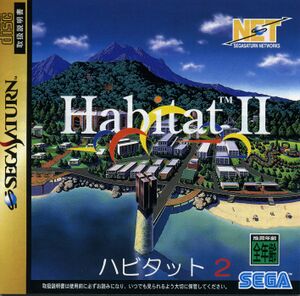Habitat II: Difference between revisions
Created page with "{{RenoInfobox |title = Habitat II |image = habitatIIcover.jpg |developer = [https://en.wikipedia.org/wiki/Fujitsu Fujitsu Limited] |publisher = [https://en.wikipedia.org/wiki/..." |
Tweaked some of the info on how Habitat II was put together in conjunction with the USA team. |
||
| Line 11: | Line 11: | ||
In 1993, Fujitsu had shown interest in bringing [https://wiki.renoproject.org/index.php/Fujitsu_Habitat Fujitsu Habitat] to the west. The plan was to backport Fujitsu Habitat to Windows computers. However, the source code for Fujitsu Habitat revealed major architectural problems and so minimal progress was made on bringing this to fruition. It was instead decided that development efforts would be better focused on writing something from the ground up. The original creators of Habitat, Chip Morningstar and Randy Farmer were both onboard and had already done this once before. | In 1993, Fujitsu had shown interest in bringing [https://wiki.renoproject.org/index.php/Fujitsu_Habitat Fujitsu Habitat] to the west. The plan was to backport Fujitsu Habitat to Windows computers. However, the source code for Fujitsu Habitat revealed major architectural problems and so minimal progress was made on bringing this to fruition. It was instead decided that development efforts would be better focused on writing something from the ground up. The original creators of Habitat, Chip Morningstar and Randy Farmer were both onboard and had already done this once before. | ||
A team in Japan was formed and they received regular code updates and support from the American WorldsAway team. The Japanese team localized everything and even added new features, such as the ability to record your session and play it back offline at any time. This was done by recording packets sent to and from the server and because of the design of the WorldsAway client, it wouldn't be able to tell the difference between receiving that data from a live server or playing back an offline recording. | |||
Habitat II was planned from the start as a way to transition from the FM Towns, over to more modern computers. The world setting was custom made by Fujitsu in Japan specifically for Habitat II and it looks like a modern Japanese city. The Habitat II world was called Elysium. | |||
== Things == | == Things == | ||
Revision as of 17:37, 27 September 2021
| Developer(s): | Fujitsu Limited |
|---|---|
| Publisher(s): | Fujitsu Limited |
| Platform(s): | Windows, Mac, Sega Saturn |
| Released: | March 1996 |
Origins
In 1993, Fujitsu had shown interest in bringing Fujitsu Habitat to the west. The plan was to backport Fujitsu Habitat to Windows computers. However, the source code for Fujitsu Habitat revealed major architectural problems and so minimal progress was made on bringing this to fruition. It was instead decided that development efforts would be better focused on writing something from the ground up. The original creators of Habitat, Chip Morningstar and Randy Farmer were both onboard and had already done this once before.
A team in Japan was formed and they received regular code updates and support from the American WorldsAway team. The Japanese team localized everything and even added new features, such as the ability to record your session and play it back offline at any time. This was done by recording packets sent to and from the server and because of the design of the WorldsAway client, it wouldn't be able to tell the difference between receiving that data from a live server or playing back an offline recording.
Habitat II was planned from the start as a way to transition from the FM Towns, over to more modern computers. The world setting was custom made by Fujitsu in Japan specifically for Habitat II and it looks like a modern Japanese city. The Habitat II world was called Elysium.
Things
More to come soon
Here's some more stuff.
Even more stuff
Here it is.
